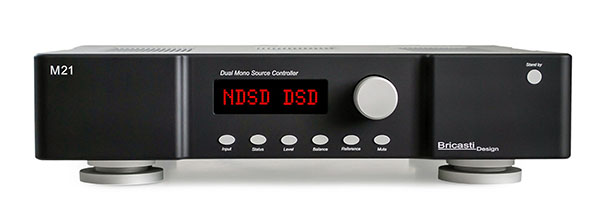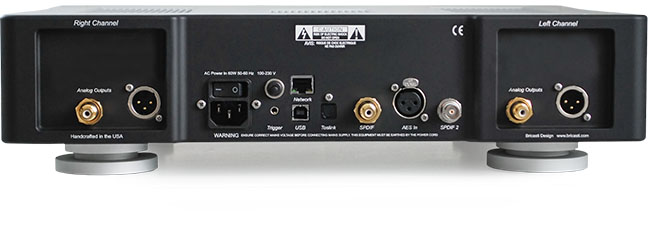Bricasti M21 DAC

 My journey in high-end audio has evolved immensely within the past 15 years. I have had the luxury of experiencing a plethora of audio equipment via purchasing, auditioning, and reviewing. Over time, I have improved my system by attending audio shows, auditioning, and reading comprehensive reviews. One of the most complex audio decisions I’ve had to make was moving on from my beloved Behold Audio gear. Since 2008, I have had the pleasure of firing up my Behold Audio gear to settle down for great listening sessions. However, I decided to change due to the age of my Behold gear and my curiosity about wanting to experience the world of audio tubes.
My journey in high-end audio has evolved immensely within the past 15 years. I have had the luxury of experiencing a plethora of audio equipment via purchasing, auditioning, and reviewing. Over time, I have improved my system by attending audio shows, auditioning, and reading comprehensive reviews. One of the most complex audio decisions I’ve had to make was moving on from my beloved Behold Audio gear. Since 2008, I have had the pleasure of firing up my Behold Audio gear to settle down for great listening sessions. However, I decided to change due to the age of my Behold gear and my curiosity about wanting to experience the world of audio tubes.
When I switched from solid state to tube gear, I carefully researched and decided on the Thrax Spartacus 300B Amplifiers and Thrax Libra Preamp. In the meantime, while using the Behold BPA768 and APU768 Preamp, the Behold amps incorporated multiple DACs within the amps, so at the time, the need for an external DAC was unnecessary. Now that I operated the Thrax gear in my system, I no longer had the luxury of internal DACs housed within the amps, thus began my search and research into finding a DAC that complimented the Thrax gear.

This review will describe what caused me to choose the M21 over the previous 2 DACs mentioned. Once again, all 3 DACs were in a class of their own, and I would have been happy with any of them. Unfortunately, I had to decide which unit best fit my budget and system for the long term.
Two main factors that drove my final decision were price and performance. The $6400 P.S. Audio Direct Stream would have complimented my system without a hitch; as far as performance is concerned, it held its own against the other 2 DACs; however, I felt the Direct Stream was a tad light in the areas of dynamics and imaging in comparison to the other two DACs while paired with the Thrax Spartacus and Libra. Price-wise, you cannot beat what the P.S. Audio Direct Stream DAC offers.
The $38,000 Thrax Maximinus DAC perfectly matched the Spartacus and Libra. It outperformed the other DACs in pure natural sonics, especially with its vivid analog presentation. Honestly, my budget was not ready to take on such a high-priced component. However, when I installed the $17,000 Bricasti M21, I was shocked at how close it performed to the Thrax Maximinus. The Bricasti performed flawlessly in the sonic region; transparency was spot on, and imaging projected a sense of meat on the bones feeling. I must admit that compared to the Thrax Maximinus, the Bricasti did not project the analog feel of the unit as mentioned earlier; however, that does not mean the Bricasti did not sound analog, just not to the $38,000 Thrax Maximinus standards. Ultimately, my decision was based on price to performance. Now that I made the tough decision to roll with the Bricasti M21 allow me to convey the factors that prompted my decision in detail.


Brief Description
The Bricasti M21 is a fully balanced circuit path D/A converter that includes separate isolated power supplies for each channel. This DAC incorporates a pair of AD1955 Analog Devices in a dual mono configuration. The M21 also incorporates an optional Ladder DAC for PCM conversion, clocking is done for each channel directly at each DAC with a technique called DDS (direct digital synthesis), which takes clock-induced jitter to immeasurable levels, and DSD is converted with its one-bit analog converter.
There are four primary internal sections to the M21, the digital input and processing section, the left and right analog and PCM DAC sections, and the left and right analog line amp with pure DSD conversion with the optional use of analog level control. The Bricasti M21 provides a network interface on the rear panel with an R.J. 45 Ethernet connection.
Build Quality
The M21 is constructed with “quality in mind”; the case is black and reminds me of a Mark Levinson design with its rugged black case and silver top, all machined from solid aluminum. To be more specific, all sections of the construction, the front and rear panels, the sides, and even the bottom and top plates are constructed with solid blocks of aluminum that are precision machine to shape, with exact tolerances for a perfect fit. Remember the four circular stainless Stillpoints feet, which provide a vibration control platform. The engineering design of the M21 is first-class.
Setting up the Bricasti M21 was straightforward: plugging in an A.C. power cord and the associated input and output interconnects. Next was choosing the DAC (NDSD, Sigma, or Ladder). Ensure the level control is set at 0db. Setting filters is an option that I played with a bit later in the sound phase. To better understand the filter settings, I contacted the manufacturer and was provided with excellent guidance. Communication with the designer was very helpful in getting and keeping me on the right track. I commend Bricasti for its superb customer service.
Initial impressions
The disappointing aspect of this review is that I can report my observations on the part of the M21’s capabilities with Redbook only. I only listened to Redbook CDs as of this writing; I needed SACDs to listen to. However, the M21 did a fantastic job on the Redbook format. I will also report on audio streaming, which the M21 performed flawlessly.
The sonic transparency, clarity, imaging, and sound staging were much better than I was accustomed to with other DACs. I was impressed with how the M21 squeezed out every minute detail with incredible clarity, organic realness, and natural reproduction. Instruments sounded lifelike without that artificial digital airiness. The different timbres perfectly separate the bass complimentary to upright bass instrument strings. The balance and presentation of instruments were like attending a live concert that touched the ear and aesthetic of individual musicians.
Using the Ladder DAC with filter options, I eventually settled on “Linear-1”; I felt this option suited my taste the best. Choosing “Linear” gave me a more open sound in the midrange and a better feel in the bass region.
Sometime down the line, I will listen to more up-sampled SACD music in addition to Redbook Compact Discs; however, the M21 is everything I need until I upgrade my CD transport.
Listening to the M21 connected to my Auralic Aires G2.1 network streamer was also a rewarding experience. The M21 provides the capability to stream audio signals through the unit; however, since I am used to streaming audio through the Auralic Aires G2.1, I decided to listen with the component connected to the Bricasti M21. The results were on point, and I felt streaming audio effects were on par with what I heard compared to music from my transport playing Redbook C.D. Finally, the timing, transparency, and resolution of the M21 while listening to streaming were astounding.
 Listening Observations/Audio Authority
Listening Observations/Audio Authority
The Bricasti M21 impressed with its clarity, transparency, overly rich bass, and airy highs. These results were apparent by hearing the results of the following music selections. Mark Isham’s “Blue Sun” presented a musical treat that floored me. I first heard the Blue Sun CD in 2007 while visiting Mr. Clement Perry’s house. I was blown away and never forgot the experience. My favorite track, “That Beautiful Sadness,” played through the M21, drew me into the very soul of what the artist intended. Just a great music track that has it all, especially for the critical listener. Mark Isham closely imitates Miles Davis, with his great horn playing. Listening to this track playing through the Thrax gear and the Bricasti M21 was the best I have heard this CD sound in my listening room. Throughout this CD, Mark Isham struts his brilliant jazz talent. Isham’s quintet includes Steve Tavaglione on tenor saxophone, David Goldblatt on piano, and the rhythmic section of drummer Kurt Wortman playing this music with grace and elegance. This CD/Album is a must for the jazz enthusiast.
 The late great Al Jarreau will always have a soft spot in my heart regarding jazz singers. The 2004 recording of “Accentuate the Positive.” It is centered around songs from the 1940s. On this album, Al Jarreau was in top form displaying limber and evocative vocals throughout each track. Accentuate the Positive moves from uptempo to bluesy tracks, culminating with Eddie Henderson’s famous “Cold Duck Time.” The M21 in the music chain helped turn the Ac-cent-tuate the Positive into a funky and expansive toe-tapper. The M21 did not disappoint by not missing a beat or note while playing this solid, poignant, and straight-ahead album. Instead, the M21 helped showcase Al Jarreau’s unique, gifted voice at its best.
The late great Al Jarreau will always have a soft spot in my heart regarding jazz singers. The 2004 recording of “Accentuate the Positive.” It is centered around songs from the 1940s. On this album, Al Jarreau was in top form displaying limber and evocative vocals throughout each track. Accentuate the Positive moves from uptempo to bluesy tracks, culminating with Eddie Henderson’s famous “Cold Duck Time.” The M21 in the music chain helped turn the Ac-cent-tuate the Positive into a funky and expansive toe-tapper. The M21 did not disappoint by not missing a beat or note while playing this solid, poignant, and straight-ahead album. Instead, the M21 helped showcase Al Jarreau’s unique, gifted voice at its best.
 Diana Krall is one of my favorite artists when I need to sit down and unwind. Her superior vocal talents and a second-to-none Jazz ensemble do it for me every time. When I sit down to listen to her on the CD “This Moment On,” I know I can relax and immerse myself in the music. With the addition of the M21, listening to this CD does it for me. While Diana Krall has always been a pleasant presence, she is also a developed and talented pianist. On the CD “This Moment On,” Diana showcases her rhythmic chops vocally and on the keyboard while listening through the combination of Thrax and the Bricasti M21. Backing her is the beautiful sounds of Clayton-Hamilton Jazz Orchestra, featuring punchy and solid solo spots by trumpeter Terell Stafford and the rhythm section talents of guitarist Anthony Wilson, bassist Robert Hurst, and drummer Jeff Hamilton. Listening to this CD with the M21 in the electronic chain brings me closer to when I heard a live performance by Diana Krall a few years ago. She is a fantastic/talented jazz artist.
Diana Krall is one of my favorite artists when I need to sit down and unwind. Her superior vocal talents and a second-to-none Jazz ensemble do it for me every time. When I sit down to listen to her on the CD “This Moment On,” I know I can relax and immerse myself in the music. With the addition of the M21, listening to this CD does it for me. While Diana Krall has always been a pleasant presence, she is also a developed and talented pianist. On the CD “This Moment On,” Diana showcases her rhythmic chops vocally and on the keyboard while listening through the combination of Thrax and the Bricasti M21. Backing her is the beautiful sounds of Clayton-Hamilton Jazz Orchestra, featuring punchy and solid solo spots by trumpeter Terell Stafford and the rhythm section talents of guitarist Anthony Wilson, bassist Robert Hurst, and drummer Jeff Hamilton. Listening to this CD with the M21 in the electronic chain brings me closer to when I heard a live performance by Diana Krall a few years ago. She is a fantastic/talented jazz artist.
Conclusion and Final Thoughts
It would be challenging to find a more formidable affordable DAC capable of what the Bricasti M21 brings to the table. While the Bricasti M21 may not be the final word in the DAC audio world, it indeed shouts its presence. For the money, performance-based, and compared to other DACs on the market that I have experienced, the Bricasti is a no-brainer. The Bricasti M21 provides a sense of sheer spaciousness, mimicking a sound more coherent to a concert venue. The sound, price performance, ease of operation, and build quality are all first-class. Highly, Highly Recommended. My 2022 Most Wanted Component.


Moreno Moreno
Bricasti M21 Specifications:
Price: $16,000
Front Panel Overview
- Front Panel has a large, simple easy to read display
- Front panel Power stand-by switch
- I.R. receiver built in for remote control operation
Rear Panel Overview
- Left and right analog output section
- 6 digital audio inputs (AES, SPDIF 1 and 2, Toslink, USB, and RJ45)
- Power connection
- Rear panel mounted circuit breaker
Operating Overview
- Input Select
- IN1 AES, Selects the XLR connector
- IN2 SPDIf Selects the RCA SPDIF connector
- IN3 EIAJ Selects the Toslink connector
- IN4 USB Selects the USB connector
- IN5 LAN and network streamer
- IN6 SPDIF 2 Selects the BNC connector
Digital Oversampling Filters for PCM conversion
- Minimum Phase
- Linear Phase
- Delta Sigma 8 x oversampling conversion
The M21 Remote
- Dedicated infrared remote control
- Six button operation
- Palm-sized for easy operation
General Specifications
- Anodized Aluminium
- Dimensions 17” x 12” x 4.5”
- Weight 15 lbs
- Shipping Weight 18 lbs
Mains Voltage
- 100, 120, 220, 240 VAC
- Power Consumption 30 Watts
- Warranty Parts and Labor 2 years non-transferable
- Roon Ready
Bricasti Design Address
- Bricasti Design, Ltd.
- 2 Shaker Rd, Bldg. N
- Shirley, MA USA 01464
- PH 1.978.425.5199
Moreno’s Associated Equipment
Analog
Thrax Spartacus 300B Amplifier
Thrax Libra Preamp
Canary C10 Phono Amp
Pro-Ject RPM 10 Carbon Turntable/ Van den Hul Stradivarius Cartridge
Otari MX5050BII2 Reel-Reel Tape Machine
Digital
Bricasti M21 DAC
Thrax Maximinus DAC
P.S. Audio PerfectWave Transport
Auralic Aires G2.1 Network Transport
Network
Auralic Aires G2.1
Roon Neutrilik
Sean Jacobs Power Supply
EtherRegen Switch
Speakers
Y.G. Acoustics Sonja 2.2i
REL G1 MKII Subwoofers 4-Stack
Cables
Hemingway
Sigma Speaker and Power Cords
Beta Interconnects
A.C. Conditioners
P.S. Audio P20
Sound Application TT-77
Accessories
Townshend Audio Seismic Platforms
StillPoints Stands S.S. Ultra 6’s
StillPoints Equipment Rack
Synergistic Research Black Box
Stereo Times Masthead
Publisher/Founder
Clement Perry
Editor
Dave Thomas
Senior Editors
Frank Alles, Mike Girardi, Key Kim, Russell Lichter, Terry London, Moreno Mitchell, Paul Szabady, Bill Wells, Mike Wright, Stephen Yan, and Rob Dockery
Current Contributors
David Abramson, Tim Barrall, Dave Allison, Ron Cook, Lewis Dardick, Dan Secula, Don Shaulis, Greg Simmons, Eric Teh, Greg Voth, Richard Willie, Ed Van Winkle, and Rob Dockery
Music Reviewers:
Carlos Sanchez, John Jonczyk, John Sprung and Russell Lichter
Site Management Clement Perry
Ad Designer: Martin Perry









Be the first to comment on: Bricasti M21 DAC